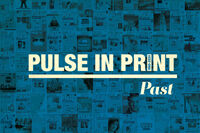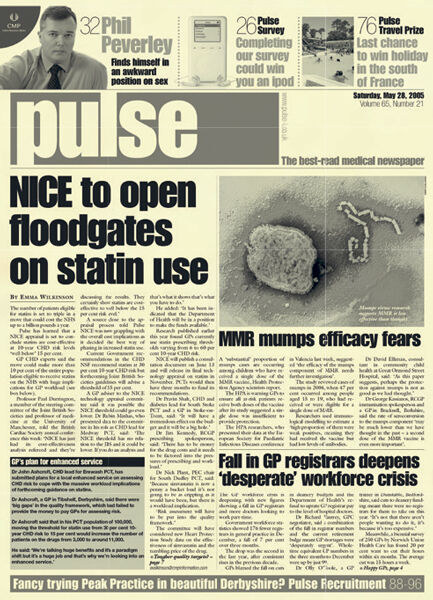
We asked the RCGP to nominate major developments in general practice since Pulse launched in 1960. The first is chronic disease management and prevention, discussed by former NICE and RCGP chair Sir David Haslam
It used to be so simple. People were well, then they got ill, got fixed, got better, or died. It was as straightforward as that. Which is, of course, nonsense – but that perception is the only explanation behind the mindset of the early years of the NHS. Policy was primarily focused on single conditions. Medical education taught about organs and their disorders, and specialties ruled – with generalism being seen as a lower form of medicine. It was as if the impact of survival after major disease was barely considered. The drama of acute illness and its treatment was the priority. Chronic disease management was a rather boring afterthought – often to be left to GPs and their developing teams.
And now everything has changed. Chronic disease management – or, to use the preferable term of long-term conditions – is central to the NHS’s challenges. Indeed, my personal history perfectly exemplifies how healthcare has evolved in the years since the NHS was formed. Back when I was a schoolboy, my hypertensive pipe-smoking GP father died of heart disease at the age of 60. Thanks to improved preventive advice, action on smoking and suitable medical intervention, I have lived much longer than my dad. However, since I reached the age at which he died, I’ve been lucky enough not just to survive, but to have the time to develop osteoarthritis – requiring a hip replacement – and cancer – requiring everything the NHS could throw at me. Those two conditions are effectively side-effects of the prevention of my heart disease. It’s little wonder that demand on the NHS keeps growing. And a legion of us with ongoing conditions has provided the NHS with a significant challenge.
Key breakthroughs
When I started in general practice, a professional lifetime ago, we lacked two developments that have profoundly changed our world – mobile phones and computing. Being dependent on landlines meant GPs had to live within their practice area for on-call. And there were no computers. None at all. Medical records were made in handwriting on pieces of cardboard stored in Lloyd George envelopes. Screening for raised blood pressure was virtually unknown. An early exception was Dr Julian Tudor Hart, almost certainly the first GP in the UK to routinely measure and act on raised blood pressure. His study of the Glyncorrwg practice showed that standardised death rates for the village in the 1980s were 28% lower than for a comparable community, while smoking rates fell over 25 years from 56% of the adult population to 20% – a remarkable development that general practice as a whole could not ignore.
Before computers arrived, practices had to depend on manual recall systems and card-index age-sex registers. Most screening was opportunistic. As the mythical average patient attended their GP four times in a year, these occasions were seen as the perfect opportunity to check blood pressure, advise about smoking and weight, and eventually make lipid checks – particularly after the development of statins during the 1970s.
And general practice then had a major unnoticed impact on the nation’s healthcare when it came to prevention. Unfortunately, when something doesn’t happen, there is no story. While the drama of resuscitation and coronary care inevitably gets headlines and plaudits, you and I, and everyone else, would prefer never to have a heart attack than to have one treated.
Primary care has a lot to be proud of.
The use and abuse of evidence
If doctors don’t know what modern research has revealed about best practice, they will continue to make the same mistakes with ever-increasing confidence. In the era when Pulse was first published, heart attacks were treated with three weeks of strict bedrest, and patients were lucky to survive without a pulmonary embolus.
By the 1970s, medical research papers were being published at a rate that would overwhelm even the most conscientious of clinicians, and it became obvious that there was a critical need for a synthesis of best practice. Good research unpicks the benefits and the risks – and it was noted that there was a significant gap between what was practised and what was effective when assessed in controlled studies, and a lag before research results found their way into practice.

Computerisation then dramatically facilitated the collection of data (although the later arrival of the QOF – in which points mean prizes – also had the potential to impact less positively on many aspects of the GP consultation). And as more data were collected, it became increasingly difficult to know how to interpret the information to the benefit of the patient.
As a result, it became important for clinicians to base their decisions on the best available evidence. Evidence-based medicine, defined as ‘the conscientious, explicit and judicious use of current best evidence in making decisions about the care of individual patients’, really took root in the early 1990s, but should never entirely replace the personalised decision-making that takes place between doctor and patient.
In 1999, faced with growing public concern about the ‘post-code lottery’ – with different drugs and treatments being available depending on where in England you lived – the Labour government established NICE. It gave the new body two main remits: to develop evidence-based best practice guidelines and to approve the use in the NHS of new drugs and treatments based on their cost effectiveness.
Guidelines should be followed unless there is a good reason not to – and there may be plenty of good reasons. After all, every NICE guideline begins by saying that it does not override healthcare professionals’ responsibility to make the most appropriate decisions based on the individual circumstances of the patient.
Such words really matter. They aren’t like the terms and conditions that accompany purchases on Amazon. They are key to the practice of good medicine. They are the antithesis of cookbook medicine, and the reason why care should be taken over the use of guidelines in developing quality metrics, particularly when income is attached.
Number crunching
Despite the importance of using evidence to guide best practice, it also has become clear that data developed for populations may be much less appropriate for use in individuals. The prescription of statins exemplifies this. While NICE guidance, for instance, can demonstrate that the prescription of a statin is cost-effective at a population level at a given level of risk, it is surely more appropriate to use tools such as NICE’s shared decision aids to help patients decide if the prescription fits with their personal health beliefs. Indeed, understanding a patient’s preferences for management has become increasingly important. Misdiagnosing a patient’s preferences can be a major cause of overprescribing. Every GP sees bags of untaken prescription drugs returned after a patient’s death. One thing the NHS can’t afford is waste.
Meanwhile, the concept of the Number Needed to Treat (NNT) will allow research evidence to be more useful in individual patients, particularly when considered with the Number Needed to Harm.
What’s next?
The complexity of so many aspects of statistical analysis means that computerisation, and in particular AI, may take a much larger role in determining optimum treatments for patients. But these will still need to accommodate patient understanding, aspirations and expectations. Multimorbidity will become increasingly important as more patients survive one condition and acquire others. The simple adoption of multiple guidelines that were developed for single conditions is likely to result in worse care, rather than better. Not only will multiple polypharmacy be likely, but patients will have lives dictated by tests, clinics and reviews – rather than living. The art of medicine, of working with patients to determine their individual best outcome, will be critical for years to come. Ultimately, computerisation will be able to adjust for multimorbidity, but we are a long way from computers understanding patients in a holistic way.
In an era of multimorbidity, the wise generalist will become more important than ever. As one of my patients said, when I explained I was not the best person to ask about the management of his prostate cancer, ‘I know you’re not an expert in prostate cancer. But you’re an expert in me’.
Sir David Haslam is former chair of NICE, past chair and president of the RCGP and the author of Side Effects: How Our Healthcare Lost Its Way, And How We Fix It

‘As we’re living longer, we’re increasingly doing so with multiple long-term conditions. Managing these safely, and considering how each one and its treatment may affect another is core to good practice. We can do so much more than even 20 years ago.’
RCGP chair Professor Kamila Hawthorne on why the college picked LTCs as one of its major breakthroughs
Pulse, 28 May 2005

‘At the time statins were the new wonder drug and the costs of treatment were coming down. There was debate about how to risk-assess people and overmedicalisation. NICE mentioned at a conference that it would be widening access to statins, which led to panic about how GPs would manage. Almost two decades on I wrote the same story as NICE reduced the threshold to under 10%.’ Emma Wilkinson, Pulse staff reporter, 2000-2005

















